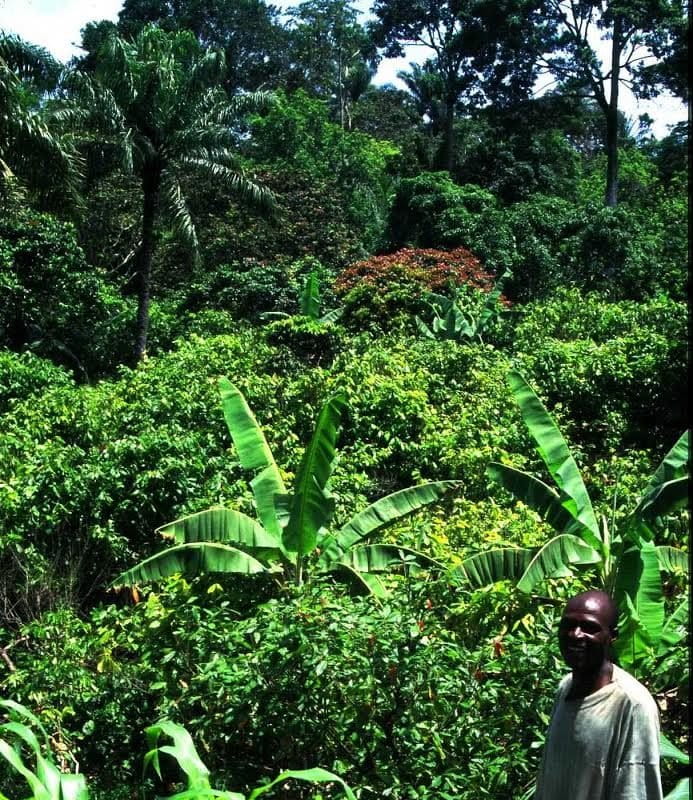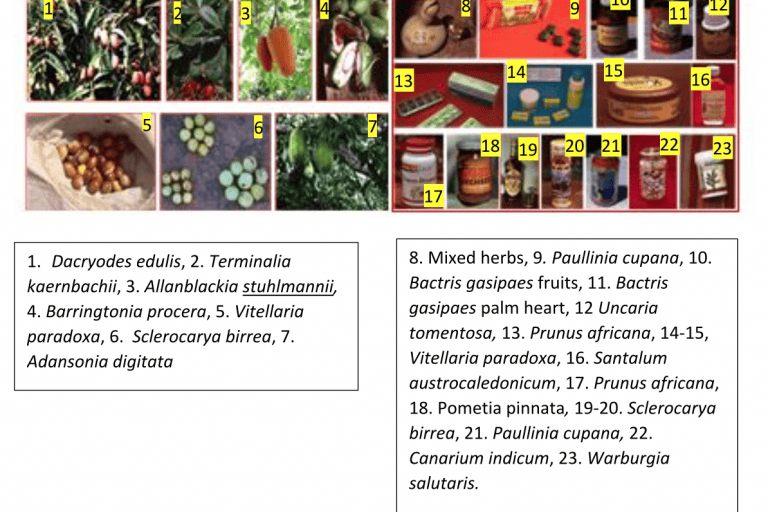- Agroforestry is a technique of growing trees and shrubs with crops, and is the focus of a new Mongabay series.
- Beside carbon sequestration, increased food security, biodiversity, topsoil depths, medicine and fiber production, plus other benefits accrue to agroforestry.
- Roger Leakey has studied, taught, and written about agroforestry techniques for decades and makes the point that trees are much more than ‘the lungs of the planet,’ but rather they also function like the skin, heart, kidneys, and intestines of the Earth, while acting as pharmacies, factories, and food pantries for humans.
- This post is a commentary. The views expressed are those of the author, not necessarily Mongabay.
There are two important answers to the question “why do we need more trees in farmland?” One is global and one is local.
Globally, trees are often recognized as the ‘lungs of the world’ because they exchange oxygen and carbon dioxide with the atmosphere. However, this is an understatement. If we think in these terms, trees are also the kidneys of the world as they regulate the flow and use of water by intercepting rain and releasing it slowly to the ground where it can either run off into rivers, or enter the groundwater. Plants can then absorb it for use in photosynthesis. This absorbed water is then transpired back to the atmosphere and blown on the wind until it falls as rain somewhere else.

Thus, trees are also like the skin of the world, being the interface between the vegetation and the atmosphere for the exchange of gases and water.
Similarly, trees are like the intestines of the world exchanging nutrients between the soil and the vegetation, fueling the nutrient and carbon cycle.
Finally, they are like the heart of the world, as they drive the ecosystems that make the world healthy and function properly. They do this by providing a very large number of niches for other organisms to inhabit, both above and below ground. Recent evidence has reported 2.3 million organisms on a single tree – mostly microbes – but also numerous insects and even bigger animals like mammals and birds. Others also live in the soil or, due to the microclimates created by the physical stature of the tree, on the associated herbs and bushes. It is all these organisms that provide the ecological services of soil formation and nutrient recycling, feeding off each other and creating an intricate web of food chains.
All this is important for the maintenance of nature’s balance that prevents weed, pest, and disease explosions. They also provide services like pollination, essential for the regeneration of most plants, not to mention the very topical regulation of carbon storage essential for climate control.

At the local level, in addition to these ‘bodily functions,’ trees produce a wide range of products useful to us, and are often traded in local markets. There are literally tens of thousands of trees that produce edible and/or useful products – sources of items of day-to-day importance for us. So, we can also think of trees as shops, civic services, and industries. Thinking in this way, a treed landscape becomes similar to a town made up of supermarkets full of everyday needs; a bank providing annual interest on investment; a drug store or health clinic for medicines; a water tower; an art gallery; a zoo full of wildlife; a guardian of culture like a museum; a hotel providing rest for migrants; a tourist center for over-wintering or summer breeding habitat; a nightclub for nocturnal creatures; factories for fertilizers, pesticides and drugs; an energy provider, and even a skyscraper affecting the flow of wind around the other buildings.
Using this analogy, we can see that by destroying trees we destroy facilities and functions important for life. Conversely, by planting trees we can multiply the products and services we need for a ‘good life’ in many different ways. In some places, trees are grown in large monoculture plantations, replicating the concept of a housing estate or industrial complex. This can be very productive but isn’t necessarily good for the environment. Alternatively, they can be grown at different densities and in different species configurations and for different products in association with food crops, livestock and cash crops.

This mixed cropping is known as ‘agroforestry’, a farming system which thrives off diversity and maximizes the availability of all the different benefits of trees and their services. In this way, agroforestry is highly beneficial to us – Homo sapiens – a dominant species in this agroecosystem. Agroforestry harnesses numerous environmental, social and economic benefits for our complex lifestyles.
This is especially important in the tropics and sub-tropics where poverty-stricken subsistence farmers struggle to feed their families and scratch a living off highly degraded land. In this situation, it can be described as hunger busting since it can improve food crop yields on exhausted soils; farmer-friendly as it has numerous social benefits including enhanced livelihoods; wildlife-friendly as it provides habitat; climate friendly as it mitigates climate change and controls water flows; wealth-promoting by producing marketable products for businesses and industries, and health-giving by producing nutritious and medicinal products. So, we could create a new, green, and much more sustainable economy.
Looking to the future, there are easily enough useful tree species for agroforestry to play all of the above roles in any corner of the inhabited world, very few of which have been cultivated to date. Interestingly, each of these species contains inherent 3- to 10-fold genetic variability at any one site, so it is easy to find and propagate individual trees that display an infinite number of useful and marketable traits suitable for a new array of businesses and industries.

However, we have hardly begun to identify the economic possibilities and need to do much more to explore all this potential. Maybe if we pursue this line of thinking, we can create useful and environmentally healthy rural landscapes which are as diverse as their urban counterparts, and create win–win–win scenarios combining better land husbandry, social empowerment, and income generation. I believe agroforestry has a bright future, but we need to learn how to manage this resource so that all people can share the benefits in harmony.
I hope this colloquial expression of the value of trees explains why agroforestry is becoming increasingly recognized as being critical if we are to manage our planet sustainably. This is particularly vital where currently the land has been deforested and degraded because trees are considered to get in the way of modern mechanized agriculture, in which monocultures are the order of the day.
Roger Leakey is Vice Chairman of the International Tree Foundation, Vice President of the International Society of Tropical Foresters, and is author of “Living with the Trees of Life – Towards the Transformation of Tropical Agriculture” (2012) and “Multifunctional Agriculture – Achieving Sustainable Development in Africa.” Learn more about his work at www.rogerleakey.com.
This article is part of a new Mongabay series about the global scope of agroforestry, see all the features here.